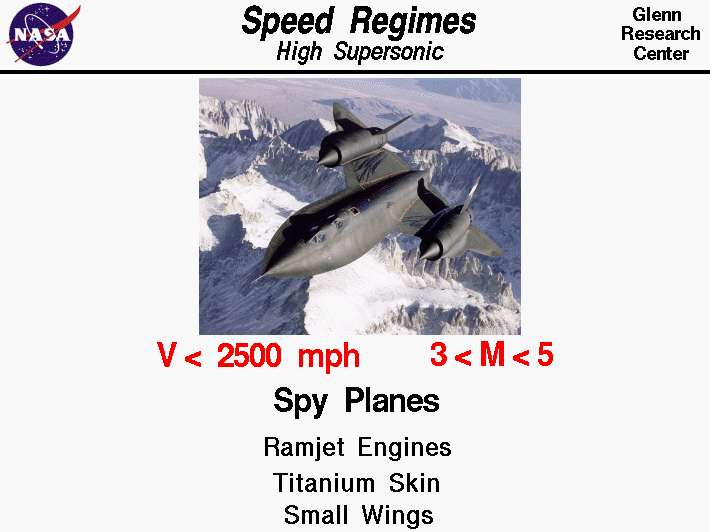
As an aircraft moves through the air, the air molecules near the
aircraft are disturbed and move around the aircraft.
Exactly how the air re-acts to the aircraft depends upon the
ratio of the speed of the aircraft to the
speed of sound through the air.
Because of the
importance of this speed ratio, aerodynamicists have designated it
with a special parameter called the
Mach number
in honor of Ernst Mach, a late 19th century physicist who studied gas
dynamics.
For aircraft speeds which are greater than the speed of sound,
the aircraft is said to be supersonic.
There are some very special aircraft which fly in the
high supersonic regime in which aircraft skin
temperature
becomes high enough that special materials must be used, by is
still low enough that the air molecules remain intact.
Typical speeds for high supersonic aircraft are greater than 1500 mph
but less than 2500 mph, and the
Mach number M is greater than three, but less
than five, 3 < M < 5.
In addition to the high temperatures, we encounter
compressibility effects
and the local
air density
varies because of
shock waves, and
expansions.
The only powered aircraft to fly in this regime were the
XB-70 and the SR-71/YF-12. An SR-71 is shown on the figure.
Both of these aircraft employed very specialized
inlet systems
to bring high speed air into the engine.
The XB-70 employed six special
afterburning turbine engines
while the SR-71 used an integrated
turbo-ramjet.
Because
lift
and
drag
depend on the square of the
velocity,
these aircraft did not require large
wing area
in cruising flight.
Like any supersonic aircraft, the wings are
swept
in planform to reduce drag.
For Mach numbers greater than 2.5, the frictional heating of
the airframe by the air becomes high enough that
light weight aluminum can not be used for the structure.
The SR-71 was made largely of titanium, which has good high
temperature characteristics, but is still light enough for
aircraft structures. During heating, any metal expands. To
allow for the expansion, slip joints are used in many places
on the SR-71. On the ground, the SR-71 fuel tanks leak, and they do
not seal until the aircraft heats up during flight.
Activities:
Guided Tours
Navigation ..

- Beginner's Guide Home Page
|
